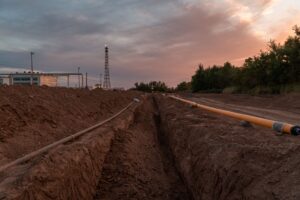In recent years, the oil and gas industry has experienced a paradigm shift in pipeline safety and management, with cloud-based leak detection technology emerging as a game-changer. This cutting-edge solution, driven by artificial intelligence and data analytics, delivers true positive alarms and reduces environmental disruption. As the industry continues to refine and optimize cloud-based leak detection systems, data analytics and visualization represent two vital components that hold the potential to propel these solutions to even greater heights.
Data analytics, the process of examining, cleaning, transforming, and modelling data to extract valuable insights, is critical in enhancing the effectiveness of cloud-based leak detection systems. By leveraging advanced data analytics, operators can make well-informed decisions based on pattern recognition and trend identification, ensuring the optimal performance and safety of pipelines.
Data visualization is the use of graphical representations, such as charts and graphs, to display data. When coupled with data analytics, visualization offers the opportunity to simplify complex data sets and provide intuitive, actionable insights that drive improved decision-making processes in leak detection and pipeline management.
In this blog post, we will delve into the powerful role data analytics and visualization play in optimizing cloud-based leak detection systems for the oil and gas industry. First, we will discuss the importance of reliable data collection and analysis in modern leak detection, examining the specific benefits of harnessing data analytics in pipeline safety and management. Next, we will explore the value of visualization in presenting actionable insights and how it can empower operators to make better-informed decisions.
1. Reliable Data Collection and Analysis: The Foundation of Modern Leak Detection
Reliable data collection and analysis are instrumental in driving the effectiveness of cloud-based leak detection systems. Gathering and processing high-quality data from pipeline sensors, monitoring devices, and other sources enables operators to make well-informed decisions regarding pipeline safety and performance. The benefits of reliable data collection and analysis encompass:
- Enhanced leak detection accuracy: Data-driven insights can help pinpoint potential leaks with higher precision, mitigating the impacts on the environment and pipeline infrastructure.
- Streamlined decision-making: Robust data analysis facilitates faster, more confident decision-making, improving the overall efficiency of pipeline operations.
- Proactive pipeline management: Effective data analysis enables operators to identify potential vulnerabilities within their systems, allowing for proactive maintenance and risk management interventions.
2. Data Analytics: Unveiling Hidden Opportunities for Improved Pipeline Safety
Data analytics plays a vital role in unlocking the potential of cloud-based leak detection systems. By leveraging advanced data analytics techniques, such as pattern recognition and trend identification, operators can extract valuable insights from complex data sets, leading to numerous benefits:
- Anomaly detection: Identifying anomalous behaviour in sensor data can help operators detect leaks of varying magnitudes and durations, ensuring comprehensive leak coverage.
- Predictive analytics: Data analytics can also reveal patterns and trends that predict potential pipeline failures, allowing operators to address issues proactively and avoid catastrophic leaks.
- Asset optimization: With data-driven analytics, operators can optimize resource allocation and reduce the overall costs of pipeline management and maintenance.
3. Data Visualization: Simplifying Complex Data and Empowering Informed Decisions
Data visualization is a powerful tool for simplifying complex data sets and presenting them via intuitive, visual representations such as charts, graphs, and maps. Coupled with data analytics, visualization can help pipeline operators gain a clear understanding of the state and health of their pipelines, leading to a range of advantages:
- Enhanced situational awareness: Data visualization demonstrates past, present, and potential future leak events, providing operators with a comprehensive overview of pipeline conditions.
- Intuitive decision-making: By simplifying complex data, visualization enables operators to make quicker, more informed decisions regarding pipeline safety and performance.
- Collaborative information sharing: Visualization facilitates the efficient sharing of data-driven insights among pipeline stakeholders, fostering collaboration and fostering improvements across the entire supply chain.
4. Integrating Data Analytics and Visualization in Cloud-Based Leak Detection Systems
The integration of data analytics and visualization in cloud-based leak detection systems provides a comprehensive solution for the oil and gas industry, offering unparalleled improvements in pipeline safety, efficiency, and performance. Implementing these advanced techniques in the leak detection process involves:
- Selecting appropriate data sources: Operators should identify relevant data sources, such as sensors, monitoring devices, and historical records, which provide the necessary information to drive analytics and visualization processes.
- Utilizing specialized software: Leveraging advanced software platforms, such as those incorporating artificial intelligence and machine learning capabilities, can optimize the processing and representation of complex pipeline data.
- Emphasizing data security: Ensuring comprehensive data security measures is essential to protecting pipeline operations from potential cybersecurity threats and maintaining data integrity.
Unlocking the Potential of Data Analytics and Visualization for the Oil and Gas Industry
Data analytics and visualization offer transformative potential for cloud-based leak detection systems, providing the oil and gas industry with unprecedented levels of safety, efficiency, and performance. These advanced techniques empower operators to make better-informed decisions regarding pipeline safety and management by simplifying complex data sets and revealing actionable insights.
As the oil and gas industry continues to evolve and leverage cutting-edge technologies, embracing data analytics and visualization within cloud-based leak detection systems will be crucial to ensuring the optimal performance of this vital infrastructure. It is an investment in the industry’s future and in promoting a sustainable and environmentally responsible approach to oil and gas production worldwide.
To learn more about how our advanced cloud-based leak detection solutions incorporate data analytics and visualization to enhance pipeline safety and performance, get in touch with the expert team at Vanmok today.













